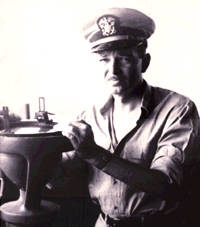Harry Hammond Hess (May 24, 1906-August 25, 1969) was an American geologist.
Considered one of the “founding fathers” of the unifying theory of plate tectonics, Rear Admiral Dr. Harry Hammond Hess was born on May 24, 1906 in New York City. He is best known for his theories on sea floor spreading, specifically work on relationships between island arcs, seafloor gravity anomalies, and serpentinized peridotite, suggesting that the convection of the Earth's mantle was the driving force behind this process. This work provided a conceptual base for the development of the theory of plate tectonics.
Hess entered Yale University as an electrical engineering major in 1923. After two years he changed to a major in geology, graduating with a B.S. degree in 1927. After his Yale education, Hess worked as an exploration geologist in Rhodesia for two years before beginning graduate studies at Princeton University. For his doctoral thesis, Hess studied an altered Virginia peridotite.
Harry Hess taught for a year (1932-1933) at Rutgers University in New Jersey and spent a year as a research associate at the Geophysical Laboratory of Washington, D. C., before joining the faculty of Princeton University in 1934. Hess remained at Princeton for the rest of his career and served as Geology Department Chair from 1950 to 1966. He was a visiting professor at the University of Cape Town, South Africa (1949-1950), and the University of Cambridge, England (1965).
Hess joined the US Navy during World War II, becoming Captain of the USS Cape Johnson a transport ship equipped with a new technology: sonar. This command would later prove to be key in Hess's development of his theory of sea floor spreading. Hess carefully tracked his travel routes to Pacific Ocean landings on the Marianas, Philippines, and Iwo Jima, continuously using his ship's echo sounder. This unplanned wartime scientific surveying enabled Hess to collect ocean floor profiles across the North Pacific Ocean, resulting in the discovery of flat-topped submarine volcanoes, which he termed guyots, after the nineteenth century geographer Arnold Henry Guyot. After the war he remained in the Naval Reserve, rising to the rank of Rear Admiral.
In 1960 Hess made his single most important contribution, which is regarded as part of the major advance in geologic science of the 20th century. In a widely circulated report to the Office of Naval Research, he advanced the theory, now generally accepted, that the earth's crust moved laterally from long, volcanically active oceanic ridges. Seafloor spreading, as the process was later named, helped establish Alfred Wegener's, earlier (but generally dismissed at the time) concept of continental drift as scientifically respectable. This triggered a revolution in the earth sciences. Hess's report was formally published in his History of Ocean Basins (1962), which for a time was the single most referenced work in solid-earth geophysics. Hess was also involved in many other scientific endeavours, including the Mohole project (1957-1966), an investigation onto the feasibility and techniques of deep sea drilling.
Hess died from a heart attack in Woods Hole, Massachusetts, on August 25, 1969, while chairing a meeting of the Space Science Board of the National Academy of Sciences.
HESS, HARRY H.
RADM USN
- DATE OF BIRTH: 05/24/1906
- DATE OF DEATH: 08/25/1969
- BURIED AT: SECTION 11 SITE 876-1
- ARLINGTON NATIONAL CEMETERY
Michael Robert Patterson was born in Arlington and is the son of a former officer of the US Army. So it was no wonder that sooner or later his interests drew him to American history and especially to American military history. Many of his articles can be found on renowned portals like the New York Times, Washingtonpost or Wikipedia.
Reviewed by: Michael Howard

